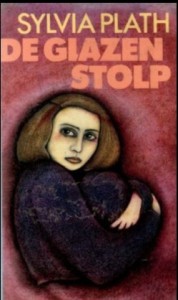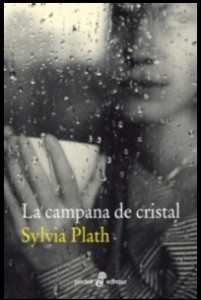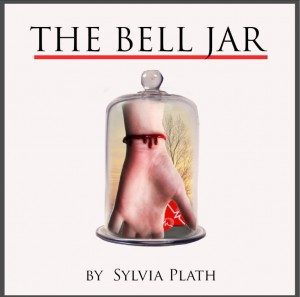

Spanish Edition. Dutch edition
Date:2005 Date: unknown
Esther greenwood is like most teenagers coming of age, young and ready to take over the world. In Esther’s case, she struggles greatly to be the normal women that society as portrait in the 1950’s. The Novel “The Bell Jar” by Sylvia Plath depicts the life of Esther Greenwood as she descent into and return from madness. Plath was descriptively committed in depicting Esther’s self absorption, confusion, and naïveté state as she struggles with society it self. The mood of the story is dark and gloomy. You can almost feel the confusion and lost state that Esther is facing.The setting of the Bell jar is set in the late 1900s. Most of the story takes place in the mental institution. Esther who is the protagonist of the story is confined to the mental institution. In there she feels depressed and irritable in her own skin. As a result of feeling this way, she delves into suicidual attempts, unresolved issues with her fathers death, her attempted rape with Marco, and her constant struggle with identity. The plot changes as Esther’s mental health improved. The mood of the story changes from dark to restoring.
The Bell Jar is a story many people can relate to. The/ ball jar covers have a rich history since the release of the story. Different publishes all around the world have created covers that portray their representation of the ball jar. The two covers I have chosen presents two different styles to illustrate takes on the classic Novel “The Bell Jar”. One represents a young women afraid to face the world and the other represents a women facing the world with all the storms and rain it comes with. Both covers exemplifies the aspects of Esther’s disturbed mind as she descends to madness.
The first cover that I choose is a 2005 Spanish edition.The cover presents a silhouette of a women photographed. The women is sitting next to a window that has a blurred out tree. The tree is at a distance, all is at view is a bright light. The light is penetrating on the right side of her face .The left side of the women’s face is darker than the right side. Her eyes are blurred out on one angle. At first glance you notice that the women is holding a mud with rain dripping down her face in a melancholic state. She has a mysterious look on her face with a slight smirk. On one side of her side you can see her eye, on the other side, her eye is blurred out, and the image is lighter on that side. This split between the two side evades aspects of Esther’s life.
The cover can be interpreted through many perspectives. Since depression and identity are major themes of this novel, they also take part in the cover as it shows how Esther descends to madness . The dark mood of the cover is a representation of Esther’s depressed state. She struggled greatly to balance what society expects and her own feelings.When Esther was in New York she had a hard time depicting who she really is and how she should behave. This comparison is shown through the black and white filter of the photographed cover. The color white in this stance represents the constantly cheerful and peppy girl that society wants and accepts. Esther feels that mankind has placed a set of rules that she can’t and will not abide by. For instance society expects her to remain a virgin until marriage but she embarks on loosing her virginity before marriage. Esther received a scholarship to go to New York for a month and work for a magazine company . Like most teenagers this should be a glorious time but Esther didn’t feel that way. As evidence shows in the story “I just bumped from hotel to work and to parties and from parties to my hotel and back to work like a numb trolley bus”. The dark contrast of the cover represents the uncertainty that Esther feels about her own abilities that later sends her to madness . She didn’t enjoy New York like the other girls as she states ” I guess I should have been excited the way most of the other girls were, but I couldn’t get myself to react. She felt “still and empty” and even dull, she had no control of her mind.
The cover can also reflect the moment Esther goes to Dr. Gordon’s hospital for her shock treatment;After not being able to sleep for seven nights or changed her clothes. The bright light of the cover penetrating from the window remains me of this scene. As Esther and her mother walked in the medical establishment they experience this same light as they describe as a “summer hotel.” (Plath, 141). When Doctor Gordon escorted Esther to her room that was “bare..at the back of house”, they saw windows that were blurred out (142). From the cover’s perspective you can see that the window is blurred out with extremely bright lights. The light in the cover symbolizes “each flash” and “great jolt” (143) that Esther felt during her shock treatment. After going through such a horrifying experience Esther sit in a chair holding “a small cocktail glass of tomato juice”. (143)
This moment is reenacted in the photographed cover of the women holding the mug with rain falling down her face. The rain shows the sadness Esther felt after her shock treatment, she didn’t feel any better as Dr. Gordon asked ” how do you feel? And she replied saying “All right, but I didn’t, I felt terrible”. (144)
The cover can also be connected to the fig tree that was mention in the Novel numerous times. In the cover, there is tree that is shown in the window at a blurred distance. This tree can be a representation of the fig tree comparison Esther mentions. In the story Esther reads about a man and a woman from two different religions who meet underneath a fig tree. She relates the fig tree to her relationship with Buddy and later thinks of the tree as her options in life . ” one fig was a husband and a happy home and children, and another fig was a famous poet..” (77). The fig tree symbolizes the life choices that Esther faces. She pictures each tree to represent a different life she would choose. She can’t make up her mind because she wanted it all, as she states ” I wanted each and every one of them, but choosing one meant losing all the rest.”(77) knowing this made Esther even more depressed, this exemplifies Esther’s mind as she goes insane.
The second cover that I choose is the Dutch edition.This cover shows a animated photo of a young lady who is Esther sitting down with her legs crawled to the side. She is sitting almost in fatal position. This symbolizes how anger Esther is at the world. She looks cold, lost scared and has no smile on her face. The women in the cover has on markup and dark eyeliner, which could represent Esther’s tired and unpleasant appearance after seven restless nights. The cover has a red background and Esther had on black clothing. This contrast represents how dark and dangerous Esther is to her own body and mind, the red represents all the demons she faces.
To face the demons in her mind that descends her to madness, Esther attempts to kill herself several times. This cover depicts Esther’s last attempt to end her life. Her first three attempts didn’t play out like she planed. She tried to slit her wrists but can only bring herself to slash her calf, She tries to hang herself, but cannot find a place to tie the rope in her low‑ceilinged house, “the trouble was, our house had the wrong kind of ceilings.” (158) At the beach with friends, she attempts to drown herself, but she keeps floating to the surface of the water. (160) For her last attempt she crawled in a basement tight space wrapped in a black coat as the cover presents. Cobwebs touched all over her face as she ” unscrewed the bottle of pills and started taking them swiftly.” (169) After taking a large quantity of the pills, she saw red and blue lights flashing in her eyes. The red lights in this moment can be a representation of the background in the image.
Another aspect of novel that relates to the cover is the moment Esther wanted to look into a mirror after attempting suicide. In the animated photo of the lady, the lady is wearing a large amount of makeup. The make up in the photo doesn’t depict this scene because Esther didn’t have make up on after taking a large amount of pills. But I do believe the make up represents Esther’s difficulty identifying herself. After her last attempt to kill take her life , she couldn’t recognize her own discolored face. She couldn’t even recognize her whole body as she states ” I look down at the yellow legs sticking out of the unfamiliar white silk pajamas they had dressed me in. The skin shook flabbily when I moved.”(172) She wanted to look into a mirror but the nurse advised her not to because she didn’t look very pretty (174) As she viewed herself in the mirror, the person she saw was not herself but a picture of someone self. She couldn’t tell whether the person in the mirror was a man or woman because the person had pale mouth, rose colored cheeks and as she described “the face was it supernatural conglomeration of bright colors.”(174) The irony of Esther in the cover wearing powder and other cosmetics portraits what Esther wants the world to view her as. She struggles greatly with identifying herself in society. The makeup she is wearing in the photo relates to Esther’s mind and how she descends to madness.
The two covers demonstrate a women that feels alone and empty.Esther felt disconnected from everything around her. She battled greatly with the world alone. In both covers it portraits a women that is mad at the world. Both women are sitting by themselves and everything else around them is not in focus. Even though they are both sitting alone, the background for each cover is different. In the Spanish edition, the background is dark with bright lights and in the Dutch edition the background is a dark red with tiny white shadings. The two covers shows how Esther felt isolated and lost, due to the dark mood of both covers.
In conclusion, both covers give the viewers two different takes on the novel. Even though both covers represent different aspects of the story, they both represent who Esther is as a women that sinks to madness. The ball jar is a novel, which as been illustrated through the eyes of many individuals throughout the world. With great artistry and great visual interpretations to create wonderful covers the Dutch edition and the Spanish edition of “The ball jar” exemplifies Esther’s inner and outer thoughts that drives her to insanity.






